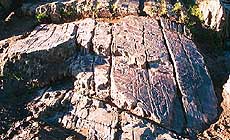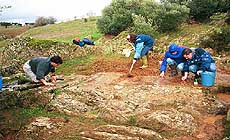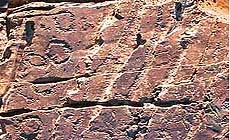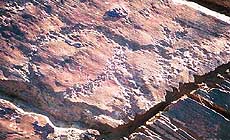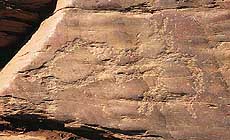 |
Description: |
Engravings
Paintings
Painted engravings
High or low-relief
Sculpture
The station is a great horizontal surface in which we see a great quantity of engravings. Engravings that are very deteriorated because of the erosion and the cracks of the rock surface.The types of engravings are quite varied, and they appear in great number, circles, pecked groups, semicircles, complex structures of lines, zoomorphs, snaky figures etc.
There are about 25-30 circles, with a diameter that varies between 4 and 10 cm; 20 semicircular forms or incomplete circles, with some measures of between 5 and 30 cm; irregular lines without defined form and crisscross; 1 snaky figures of 21 cm of longitude, the thickness of its line is more or less of 2 cm; Zoomorph in horizontal position, is not very well conserved, although we can see the paws, the circular body, the neck, the head and the horns. It has 14 cm of long for 11 of wide. Associated to the previous figure, we see another possible zoomorph, worse conserved, in vertical position. Of this we only appreciate the circular body, the paws and the neck and the head. These two figures in association probably perform one of the rare scenes of schematic figures with indication of movement that can be interpretated as male zoomorphs fight.
Another attractive motif in this station is a practically rectangular structure that is developed in a deep crack taking two different planes in the rock. The structure has 1.15 m. long for 30 cm of wide. In the interior, and associated to the line that forms the figure we see semicircular forms, pricked groups, in the left end, a group of thread like lines, in vertical, horizontal and inclined position.Their dimensions vary between 35 and 3 cm of long. It is difficult to number the quantity of figures that there is in this station. They have been considered groups of lines and of points like figures, although the quantity of indefinite motifs is bigger and more difficult of numbering. Besides, this rock is extremely interesting because of the double face figure described, remarked for its technical and executional complexity.
|
Figures: |
total number 60
zoomorph, snaky figure, circle, thread like lines, groups of pecked, semicircles, indefinite.
|
|
 |
Chronology: |
Palaeolithic
Epipalaeolithic - Mesolithic
Neolithic
Copper Age
Bronze Age
Iron Age
Roman
Middle Age
Modern
Unknown
EPIPALEOLITHIC (IX millenium b.C) // NEOLITHIC (IV-III millenia b. C.)// COPPER AGE ( II milenium b. C.).
|
Notes: |
EUROPREART DB Cheles records are just a little sample in short of the hole documentation of the site. All the documentation is registered in our own DB, and you can ask for more information at the e.mail adress barbaon@terra.com. |
|
 |
 NEW: Alpine rock paintings
NEW: Alpine rock paintings